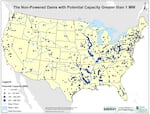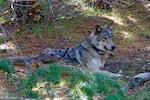
In this photo released by the Wild Salmon Center, a coho salmon is analyzed by "Salmon Vision," a new fish-counting technology developed in concert with First Nations fishery managers in Canada.
Le Colibri/ Wild Salmon Center
Helping salmon with artificial intelligence
Salmon in the Pacific Northwest have been hit hard by habitat destruction and climate change. Because different numbers of fish return each year, fishery managers have to be nimble to make sure overfishing doesn’t occur. But counting returning salmon is labor-intensive and often results aren’t known in time to make the needed adjustments.
Researchers from the Wild Salmon Center in Portland and Simon Fraser University in British Columbia worked with First Nations fishery programs to overcome this data problem. They’ve developed a new machine learning technology, dubbed “Salmon Vision” that automates fish counting.
They tested Salmon Vision on video from two fish weirs operated by First Nations groups in BC. The technology was able to ID 12 different species of fish with 68% accuracy. But for sockeye and coho salmon, two of the most important fisheries, the program ID’d the fish correctly 84% and 95% respectively.
The researchers hope Salmon Vision will eventually be able to provide real-time data about how many salmon are returning each year.
Read more about the discovery in the journal Frontiers in Marine Science here.
Brain atlas
Our understanding of the human brain has come an astoundingly long way, but in many ways neurobiologists have been operating in the dark. They’ve been limited by a relative lack of knowledge about the brain’s basic cellular make-up and organization.
But now what we know has taken a huge leap forward. Scientists at the Allen Institute in Seattle, the University of Washington and other research institutions have created the most detailed cellular map of the human brain yet. There are hundreds of billions of cells in your brain. Previously, researchers had ID’d fewer than 200 different types. The new map catalogs more than 3,000 types of cells.
The new information, published in 21 different papers, will lead to a greater understanding of how the brain works. It will also help us know where to look for solutions when something goes wrong, like in instances of disease and brain disorders.
Access the entire suite of new research from the journals Science, Science Advances and Science Translational Medicine here.
More hydropower without more dams
There are an incredible number of dams — nearly 92,000 — in the United States. Yet only 3% of those dams generate hydropower, a source of carbon-free electricity needed to battle climate change.
So what if we could convert some of these existing non-energy-generating dams to hydropower? It could save money, permitting time and avoid additional environmental damage created by dam-building.
Researchers at Idaho National Laboratory and Pacific Northwest National Lab have developed a new tool designed to help evaluate which non-powered dams have the best potential for conversion. The tool looks at potential impacts on the grid, communities, industry and the environment to help make prioritizations on the national level.
By converting non-powered dams, there’s potential to add 12 gigawatts of new renewable energy to the country’s energy mix — enough to power 4.8 million homes.
Find out more about the new tool here.

This figure from a 2012 U.S. Department of Energy report shows the locations of the top non-powered dams with potential hydropower capacities greater than 1 megawatt. National labs in Idaho and Washington have developed a new tool to help prioritize hydropower conversion sites across the country.
Oakridge National Laboratory
Cell factories made faster
Immunotherapy is a kind of cancer treatment that harnesses the power of your own immune system to fight off cancer. One immunotherapy strategy, referred to as CAR-T, requires modifying immune system T-cells to recognize and destroy cancer. But you have to grow and inject a heap of these modified white blood cells to make it work, and this process can be slow. Access to the treatment can be limited because cell manufacturing hasn’t been able to keep up.
Researchers at Washington State University have figured out a way to grow those cells 30% faster than current methods. They’ve created a new cell incubator of sorts, about the size of a minifridge, that promotes quicker cell multiplication and growth.
They’ve tested the new device on cow T-cells and are planning to test with human cells next. The researchers say the technology has the potential to produce three immunotherapy doses every three days. Such therapy can now take more than a week to produce.
Read the results in the journal Biotechnology Progress here.

Researchers at Oregon State University-Cascades and the OSU veterinary school have identified a bacteria in wolves, like the Oregon wolf shown in this file photo, that could help ease the condition called irritable bowel syndrome, or IBS, in domesticated dogs.
Courtesy U.S. Fish and Wildlife Service / AP
Wolf guts could boost dog health
Like humans, dogs can develop inflammatory bowel disease, and the results aren’t pleasant: chronic vomiting, gas, weight loss and other symptoms. And there’s no cure.
But researchers at Oregon State University-Cascades and the OSU veterinary school have identified a bacteria that could help ease the condition called irritable bowel syndrome, or IBS. The scientists isolated the bacteria from the intestines of a wild gray wolf that had died after being hit by a car.
The researchers say the diets of domesticated dogs — which are higher in carbohydrates than wolves — have shifted their gut microbiome, making them more susceptible to IBS. In lab tests, the bacteria from wolf guts, dubbed Paenibacillus sp. ClWae2A, suppressed certain harmful bacteria and helped in the digestion of complex carbohydrates.
The scientists say this bacteria could be used as a probiotic that could help head off canine IBS. They’re also investigating several other gut bacteria collected from the wolf for beneficial qualities.
Read the paper in the journal Applied Microbiology here.
In this monthly rundown from OPB, “All Science. No Fiction.” creator Jes Burns features the most interesting, wondrous and hopeful science coming out of the Pacific Northwest.
And remember: Science builds on the science that came before. No one study tells the whole story.
